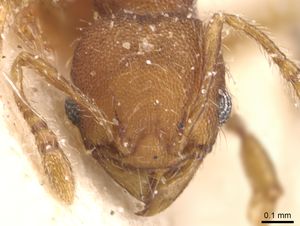Pheidole scrobifera
| Pheidole scrobifera | |
|---|---|

| |
| Scientific classification | |
| Kingdom: | Animalia |
| Phylum: | Arthropoda |
| Class: | Insecta |
| Order: | Hymenoptera |
| Family: | Formicidae |
| Subfamily: | Myrmicinae |
| Tribe: | Attini |
| Genus: | Pheidole |
| Species: | P. scrobifera |
| Binomial name | |
| Pheidole scrobifera Emery, 1896 | |
According to Longino (1997), as well as Stefan Cover and James C. Trager (independent field notes), scrobifera is relatively common in mature wet forest, nesting in rotten logs and other pieces of rotten wood on the forest floor. Workers have been observed foraging at night. (Wilson 2003)
Identification
See the description in the nomenclature section.
Keys including this Species
Distribution
Atlantic slope of Costa Rica to 900 m (Longino 1997).
Latitudinal Distribution Pattern
Latitudinal Range: 13.7695496° to 9.4817844°.
| North Temperate |
North Subtropical |
Tropical | South Subtropical |
South Temperate |
- Source: AntMaps
Distribution based on Regional Taxon Lists
Neotropical Region: Costa Rica (type locality), Honduras, Nicaragua, Panama.
Distribution based on AntMaps
Distribution based on AntWeb specimens
Check data from AntWeb
Countries Occupied
| Number of countries occupied by this species based on AntWiki Regional Taxon Lists. In general, fewer countries occupied indicates a narrower range, while more countries indicates a more widespread species. |

|
Estimated Abundance
| Relative abundance based on number of AntMaps records per species (this species within the purple bar). Fewer records (to the left) indicates a less abundant/encountered species while more records (to the right) indicates more abundant/encountered species. |

|
Biology
Castes
Worker
Minor
Images from AntWeb
   
| |
| Syntype of Pheidole scrobifera. Worker. Specimen code casent0904450. Photographer Will Ericson, uploaded by California Academy of Sciences. | Owned by MSNG, Genoa, Italy. |
Nomenclature
The following information is derived from Barry Bolton's Online Catalogue of the Ants of the World.
- scrobifera. Pheidole scrobifera Emery, 1896g: 73, pl. 1, fig. 14 (s.w.q.m.) COSTA RICA. Combination in P. (Scrobopheidole): Emery, 1915i: 190. See also: Wilson, 2003: 629.
Unless otherwise noted the text for the remainder of this section is reported from the publication that includes the original description.
Description
From Wilson (2003): DIAGNOSIS Distinguished from other members of the scrobifera group as follows.
Major: pilosity very short, absent on anterior half of dorsal profile of head and present as uniform, suberect hairs along the posterior half of the profile; entire dorsal head surface posterior to the eyes rugoreticulate; promesonotal sculpturing consisting entirely of foveolation; petiolar and postpetiolar nodes entirely smooth and shiny; head capsule with bilateral dark spots.
Minor: humerus cornulate; propodeal spines long and slender; dorsal head surface and all of mesosoma foveolate, with no carinulae or rugulae anywhere on the body.
MEASUREMENTS (mm) Major (La Selva Biological Station, Costa Rica): HW 0.88, HL 1.08, SL 0.42, EL 0.14, PW 0.54. Minor (La Selva Biological Station): HW 0.44, HL 0.46, SL 0.36, EL 0.10, PW 0.30.
COLOR Major: head and mandibles light reddish brown, with bilateral dark brown spots on the dorsal surface, as illustrated; mesosoma a slightly lighter shade of light reddish brown; waist, gaster, legs, and antennae brownish yellow.
Minor: head and mesosoma dark, slightly reddish yellow; appendages clear medium yellow.
Figure. Upper: major (right hind femur shown at bottom). Lower: minor. COSTA RICA: La Selva Biological Station, near Puerto Viejo , col. Stefan Cover. Scale bars = 1 mm.
Type Material
Jiménez, near Guapiles, Costa Rica. Museo Civico di Storia Naturale, Genoa - as reported in Wilson (2003)
Etymology
L scrobifera, trench-bearer, alluding to the antennal scrobes. (Wilson 2003)
References
- Emery, C. 1896g. Studi sulle formiche della fauna neotropica. XVII-XXV. Bull. Soc. Entomol. Ital. 28: 33-107 (page 73, pl. 1, fig. 14 soldier, worker, queen, male described)
- Emery, C. 1915g. Noms de sous-genres et de genres proposés pour la sous-famille des Myrmicinae. Modifications à la classification de ce groupe (Hymenoptera Formicidae). Bull. Soc. Entomol. Fr. 1915: 189-192 (page 190, Combination in P. (Scrobopheidole))
- Wilson, E. O. 2003. Pheidole in the New World: A dominant, hyperdiverse ant genus. Harvard University Press, Cambridge, MA. (page 629, fig. major, minor described)
References based on Global Ant Biodiversity Informatics
- Fernández, F. and S. Sendoya. 2004. Lista de las hormigas neotropicales. Biota Colombiana Volume 5, Number 1.
- Kempf, W.W. 1972. Catalago abreviado das formigas da regiao Neotropical (Hym. Formicidae) Studia Entomologica 15(1-4).
- Longino J. T. 2013. Ants of Nicargua. Consulted on 18 Jan 2013. https://sites.google.com/site/longinollama/reports/ants-of-nicaragua
- Longino J. T. L., and M. G. Branstetter. 2018. The truncated bell: an enigmatic but pervasive elevational diversity pattern in Middle American ants. Ecography 41: 1-12.
- Longino J. et al. ADMAC project. Accessed on March 24th 2017 at https://sites.google.com/site/admacsite/



